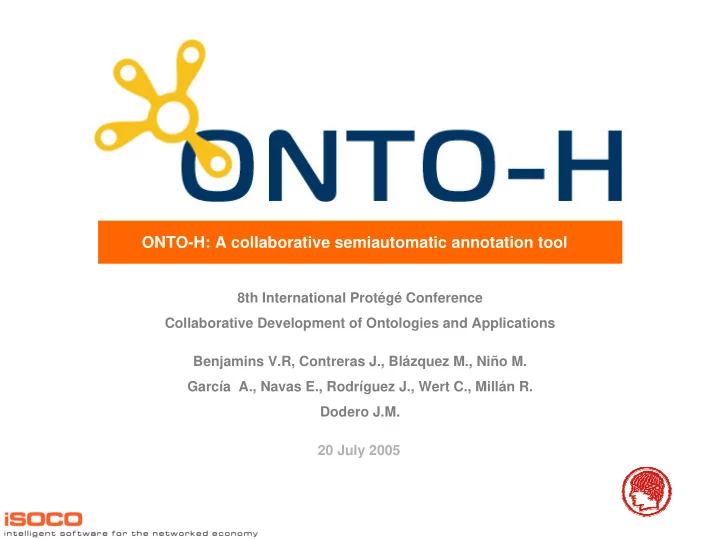

ONTO-H: A collaborative semiautomatic annotation tool 8th International Protégé Conference Collaborative Development of Ontologies and Applications Benjamins V.R, Contreras J., Blázquez M., Niño M. García A., Navas E., Rodríguez J., Wert C., Millán R. Dodero J.M. 20 July 2005
Cultural Domain: Requirements � 20 years ago… Scarceness of information • No easy availability of cultural knowledge • Precious originals only available in specific libraries � Nowadays… Information overload • Huge amount of data (OCR input, books, etc.) � Retrieval requirements for research activities • Keyword based search is not enough • Multiple sources, even contradictions • Complex relations between persons, art works, etc. • Complex reference treatment (names, pseudonyms, etc.) 2
Cultural Domain - Requirements � Huge amount of data (OCR input, books, etc.) � Information overload • Many databases • CD collections � Retrieval requirements for research activities • Keyword based search is not enough • Multiple sources, even contradictories • Complex relations between persons, art works, etc. • Complex reference treatment (names, pseudonyms, etc.) 3
Solution � Build an acceptable ontology of Humanities. � Use the ontology to semantically annotate existing cultural content. � Support the annotation process by an “intelligent” editor. � Provide a collaborative environment. 4
Ontology Creation and Description � Interdisciplinary teams (working for over 1 year) � Competency questions approach • “Editors of the Gaceta Literaria journal” • “List of every author qualified as post-modernist” • “Who participated in any congress held in Seville in 1920?” � Import and merge concepts from external ontologies • WordNet • CyC • SUO � Concepts: • Studies, Profession, Company, Institution, Expresion, Manifestation…. 5
Functionalities � High cost for manual annotation : 10.000$ per page � Intelligent Editor • Annotation Rules (automates the process) • Recommendations - Natural Language Processing • Conflict resolutions - Duplicate Names or References • Search Facilities • Import Facilities • Collaborative environment. 6
� Annotation • The annotation process does not change the source text itself • Creates a link from the instance to the original text • Attributes related with the annotation: - Annotator: annotator’s name. - Annotation date. - Reference : this attribute identifies the instance. The value that it takes is the selected text - Source link: - File’s name, offset and text selected. - State: For reviewing process. By default its value is ‘provisional’ 7
8 � Annotation:
� Rules (Drag & Drop) • Examples: - New instance of class Person creates a new instance of the class “Naming”. - Pablo Picasso and Pablo Ruíz Picasso are the same person with different nominations. - Create New artistic work - Makes sense to create new instances for its manifestation and expression - Guernica is a work - Expression: is a painting - Manifestation: the actual painting at Reina Sofia Museum in Madrid 9
10
11
� Recommendations • Increase the accuracy of the editor. • The users ask for advice for selected words or text parts. • Suggestion of possible concepts for the selected text. • Checks using NLP. 12
� Conflict Resolution • One of the most complex concepts in the ontology is NAME. • Almost all things can be named in different ways. - Author, places, works, etc can posses a number of names depending on the time. • All of these names should point to the same instance. • Instance name duplication • The user can select between different possibilities: - Add new instance - Modify the existent one - Nothing 13
14
Ontology Population � Search Facilities • Instance search - Marking all the instances define at the ontology at text - Search an specific instance of ontology. - All instances that has a reference to other instance • Text Search facilities - Caps - With or without accents 15
16
17
Ontology Population � Import Facilities • Import data from XML files with a specific structure - Persons - Places - Activities - Relations between persons and places - Relations between persons and activities - Etc. • Conflict detection • Suggest different options to the user 18
Collaborative Tool � Using Protégé 3.0 server. � Package: • All modifications made by an annotator during a working session � Two main roles • Reviewer - Ontology Schema Management - Reviews a unit called PACKAGE - If rejects a single instance, reviewer rejects all the instances contained at a Package - If accepts a package, the reviewer accepts all the modifications. • Annotator - Creates instances at the knowledge base. - Receive messages if the package is rejected. 19
Conclusions � Ontology: • Classes: 64 • Instances: 77087 • Slots: 91 • Database backend � Use of Rules to populate the ontology (Drools). � Acknowledgements • ONTO-H (PROFIT, SEGEPAC and ESPERONTO Services (IST-2001-34373) 20
Questions 21 � Thank You!
Recommend
More recommend